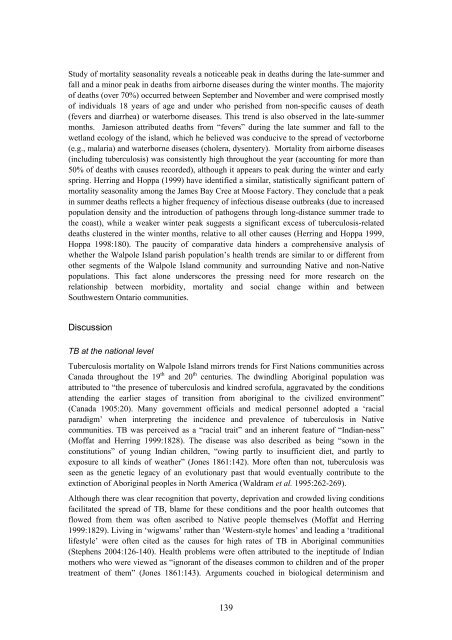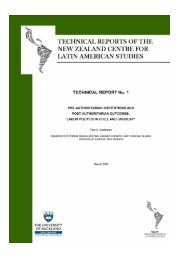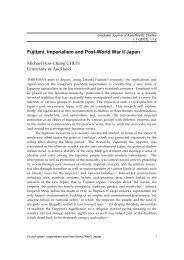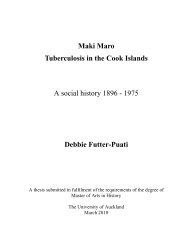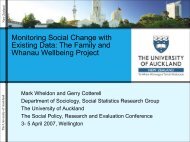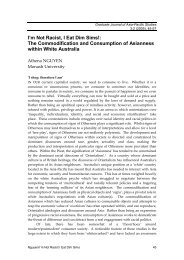Multiplying and Dividing - The University of Auckland
Multiplying and Dividing - The University of Auckland
Multiplying and Dividing - The University of Auckland
Create successful ePaper yourself
Turn your PDF publications into a flip-book with our unique Google optimized e-Paper software.
Study <strong>of</strong> mortality seasonality reveals a noticeable peak in deaths during the late-summer <strong>and</strong>fall <strong>and</strong> a minor peak in deaths from airborne diseases during the winter months. <strong>The</strong> majority<strong>of</strong> deaths (over 70%) occurred between September <strong>and</strong> November <strong>and</strong> were comprised mostly<strong>of</strong> individuals 18 years <strong>of</strong> age <strong>and</strong> under who perished from non-specific causes <strong>of</strong> death(fevers <strong>and</strong> diarrhea) or waterborne diseases. This trend is also observed in the late-summermonths. Jamieson attributed deaths from “fevers” during the late summer <strong>and</strong> fall to thewetl<strong>and</strong> ecology <strong>of</strong> the isl<strong>and</strong>, which he believed was conducive to the spread <strong>of</strong> vectorborne(e.g., malaria) <strong>and</strong> waterborne diseases (cholera, dysentery). Mortality from airborne diseases(including tuberculosis) was consistently high throughout the year (accounting for more than50% <strong>of</strong> deaths with causes recorded), although it appears to peak during the winter <strong>and</strong> earlyspring. Herring <strong>and</strong> Hoppa (1999) have identified a similar, statistically significant pattern <strong>of</strong>mortality seasonality among the James Bay Cree at Moose Factory. <strong>The</strong>y conclude that a peakin summer deaths reflects a higher frequency <strong>of</strong> infectious disease outbreaks (due to increasedpopulation density <strong>and</strong> the introduction <strong>of</strong> pathogens through long-distance summer trade tothe coast), while a weaker winter peak suggests a significant excess <strong>of</strong> tuberculosis-relateddeaths clustered in the winter months, relative to all other causes (Herring <strong>and</strong> Hoppa 1999,Hoppa 1998:180). <strong>The</strong> paucity <strong>of</strong> comparative data hinders a comprehensive analysis <strong>of</strong>whether the Walpole Isl<strong>and</strong> parish population’s health trends are similar to or different fromother segments <strong>of</strong> the Walpole Isl<strong>and</strong> community <strong>and</strong> surrounding Native <strong>and</strong> non-Nativepopulations. This fact alone underscores the pressing need for more research on therelationship between morbidity, mortality <strong>and</strong> social change within <strong>and</strong> betweenSouthwestern Ontario communities.DiscussionTB at the national levelTuberculosis mortality on Walpole Isl<strong>and</strong> mirrors trends for First Nations communities acrossCanada throughout the 19 th <strong>and</strong> 20 th centuries. <strong>The</strong> dwindling Aboriginal population wasattributed to “the presence <strong>of</strong> tuberculosis <strong>and</strong> kindred scr<strong>of</strong>ula, aggravated by the conditionsattending the earlier stages <strong>of</strong> transition from aboriginal to the civilized environment”(Canada 1905:20). Many government <strong>of</strong>ficials <strong>and</strong> medical personnel adopted a ‘racialparadigm’ when interpreting the incidence <strong>and</strong> prevalence <strong>of</strong> tuberculosis in Nativecommunities. TB was perceived as a “racial trait” <strong>and</strong> an inherent feature <strong>of</strong> “Indian-ness”(M<strong>of</strong>fat <strong>and</strong> Herring 1999:1828). <strong>The</strong> disease was also described as being “sown in theconstitutions” <strong>of</strong> young Indian children, “owing partly to insufficient diet, <strong>and</strong> partly toexposure to all kinds <strong>of</strong> weather” (Jones 1861:142). More <strong>of</strong>ten than not, tuberculosis wasseen as the genetic legacy <strong>of</strong> an evolutionary past that would eventually contribute to theextinction <strong>of</strong> Aboriginal peoples in North America (Waldram et al. 1995:262-269).Although there was clear recognition that poverty, deprivation <strong>and</strong> crowded living conditionsfacilitated the spread <strong>of</strong> TB, blame for these conditions <strong>and</strong> the poor health outcomes thatflowed from them was <strong>of</strong>ten ascribed to Native people themselves (M<strong>of</strong>fat <strong>and</strong> Herring1999:1829). Living in ‘wigwams’ rather than ‘Western-style homes’ <strong>and</strong> leading a ‘traditionallifestyle’ were <strong>of</strong>ten cited as the causes for high rates <strong>of</strong> TB in Aboriginal communities(Stephens 2004:126-140). Health problems were <strong>of</strong>ten attributed to the ineptitude <strong>of</strong> Indianmothers who were viewed as “ignorant <strong>of</strong> the diseases common to children <strong>and</strong> <strong>of</strong> the propertreatment <strong>of</strong> them” (Jones 1861:143). Arguments couched in biological determinism <strong>and</strong>139


